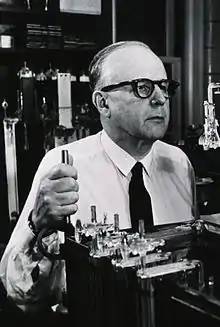Dean Burk | |
|---|---|
 | |
| Born | Dean Turner Burk March 21, 1904 Oakland, California, U.S. |
| Died | October 6, 1988 (aged 84) Washington, D.C., U.S. |
| Other names | M. Dean Burk |
| Education | University of California, Davis |
| Alma mater | University of California, Berkeley |
| Spouse | Mildred Chaundy Burk[1] |
| Parent |
|
Dean Turner Burk (March 21, 1904 – October 6, 1988)[2] was an American biochemist, medical researcher, and a cancer researcher at the Kaiser Wilhelm Institute and the National Cancer Institute.[3] In 1934, he developed the Lineweaver–Burk plot together with Hans Lineweaver.[4] Lineweaver and Burk collaborated with the eminent statistician W. Edwards Deming on the statistical analysis of their data:[5] they used the plot for illustrating the results, not for the analysis itself.
Early life
Dean Turner Burk was born on March 21, 1904, in Oakland in Alameda County.[6] Dean was the second of four sons born to Frederic Lister Burk, the founding President of the San Francisco Normal School, a preparatory school for teachers which eventually became San Francisco State University.
He entered the University of California, Davis at the age of 15. A year later, he transferred to the University of California, Berkeley, where he received his B.S. degree in Entomology in 1923. Four years later, he earned a Ph.D. in biochemistry.
Professional career
Burk joined the Department of Agriculture in 1929 working in the Fixed Nitrogen Research Laboratory.[3] In 1939, he joined the Cancer Institute as a senior chemist. He was head of the cytochemistry laboratory when he retired in 1974. He also taught biochemistry at the Cornell University Medical School from 1939 to 1941.[3] He was a research master at George Washington University. Burk was a close friend and co-author with Otto Heinrich Warburg.[7] He was a co-developer of the prototype of the Magnetic Resonance Scanner.[3][8] Burk published more than 250 scientific articles in his lifetime.[9] He later became head of the National Cancer Institute's Cytochemistry Sector in 1938, although he is often mistaken as leading the entire facility.
Retirement
After retiring from the NCI in 1974, Dean Burk remained active. He devoted himself to his opposition to water fluoridation.[10][11] He and a coauthor published an analysis of cancer mortality in 10 cities that fluoridated the drinking water supply and 10 that didn't. The paper was criticized for using overly broad grouping and making assumptions about variations in racial composition of cities. Epidemiologists from the National Cancer Institute analyzed the findings and found no significant increase in cancer mortality associated with fluoridation.[12][13] Burk considered "fluoridation as "mass murder on a grand scale."[14] Dean Burk argued on Dutch television against a water fluoridation proposal which was before the Dutch Parliament in the Netherlands.[13] He also was an avid supporter of laetrile; an alleged cancer treatment regarded by the medical community as ineffective and potentially dangerous.[15]
Recognition
For his work on photosynthesis, Dean Burk received the Hillebrand Prize in 1952. Dean Burk and Otto Heinrich Warburg discovered the photosynthesis I-quantum reaction that splits CO2 activated by respiration.[16][17] For his techniques to distinguish between normal cells and those damaged by cancer, Dean Burk was awarded the Gerhard Domagk Prize in 1965.[18]
References
- ↑ Robert Welkos (October 11, 1988). "Dean Burk, Supporter of Laetrile, Dies". Los Angeles Times. Retrieved 18 October 2019.
- ↑ "Essig Museum of Entomology Collections". essigdb.berkeley.edu. Retrieved 2024-01-12.
- 1 2 3 4 "Dean Burk, 84, Chemist for Cancer Institute". New York Times. Associated Press. October 10, 1988. p. B8.
- ↑ Lineweaver, H; Burk, D. (1934). "The Determination of Enzyme Dissociation Constants". Journal of the American Chemical Society. 56 (3): 658–666. doi:10.1021/ja01318a036..
- ↑ Lineweaver H, Burk D, Deming, W E (1934). "The dissociation constant of nitrogen-nitrogenase in Azobacter". Journal of the American Chemical Society. 56: 225–230. doi:10.1021/ja01316a071.
{{cite journal}}: CS1 maint: multiple names: authors list (link) - ↑ "Essig Museum of Entomology Collections". essigdb.berkeley.edu. Retrieved 2024-01-12.
- ↑ Weiterentwicklung der zellphysiologischen Methoden: angewandt auf Krebs, Photosynthese und Wirkungsweise der Röntgenstrahlung: Arbeiten aus den Jahren 1945–1961, (Thieme, Stuttgart 1962) (Trans: Further Developments of Methods in Cellular Physiology applied to Cancer, Photosynthesis and the Effects of X-ray Radiation) Texts in German and English.
- ↑ I Weisman, L. Bennett, L. Maxwell Sr., M. Woods, and D. Burk (1972)"Recognition of Cancer in vivo by Nuclear Magnetic Resonance", Science 178, 1288 – 1290.
- ↑ Burk D, Schade AL. On respiratory impairment in cancer cells. Science. 1956 Aug 10;124(3215):270-2.
- ↑ J Yiamouyiannis, D Burk "Fluoridation and cancer, age-dependence of cancer mortality related to artificial fluoridation" Fluoride 1977.
- ↑ Consumer Health Articles: FLUORIDATION
- ↑ Clemmesen J (1983). "The alleged association between artificial fluoridation of water supplies and cancer: a review". Bull World Health Organ. 61 (5): 871–83. PMC 2536164. PMID 6360403.
- 1 2 619 F. 2d 932 – Yiamouyiannis v. Consumers Union of United States Inc
- ↑ Archived at Ghostarchive and the Wayback Machine: Dr. Dean Burk - Fluoride causes cancer. YouTube.
- ↑ Burk, D. (1970). Laetrile and Cancer. Science News.
- ↑ Burk, D.; Warburg, O. (1950). "1-Quanten-Mechanismus und Energie-Kreisprozess bei der Photosynthese". Arch. Biochem. 37 (24): 560. Bibcode:1950NW.....37..560B. doi:10.1007/BF00601375. S2CID 28860370.
- ↑ Otto Warburg - Biography - Nobelprize.org
- ↑ "Dean Burk, 84, Chemist for Cancer Institute". The New York Times. October 10, 1988.